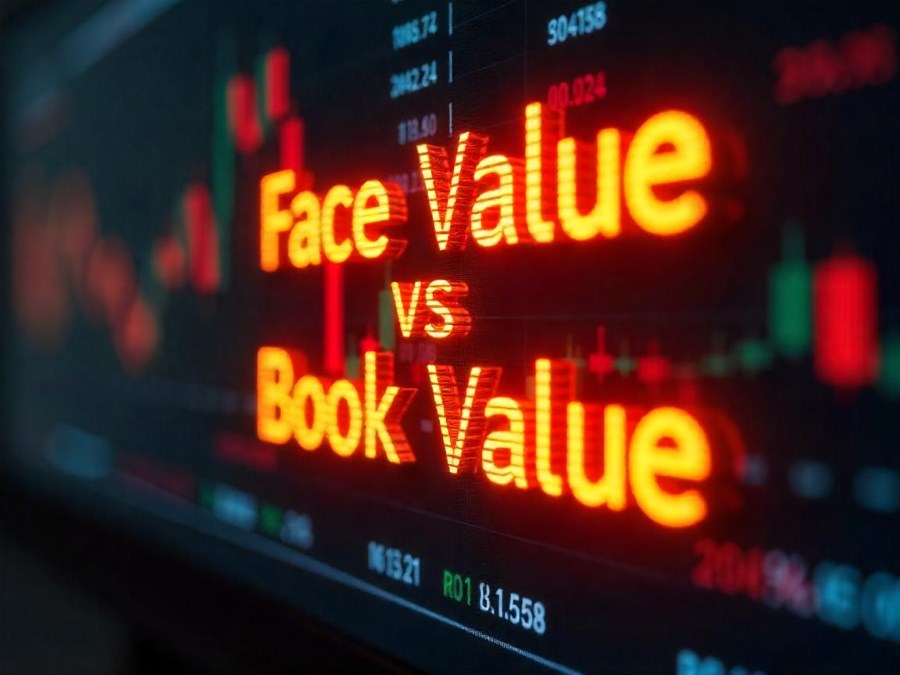Simplifying Life Insurance in India
8 Difference Between Book Value and Face Value

Every investor wants to understand the actual value of a company. However, many overlook two basic financial concepts: book value and face value. While people may use these terms interchangeably, they contain fundamentally different meanings. Book value indicates the actual net worth of a company, as reflected in its balance sheet.
Face value shows the nominal value of a financial instrument that the issuer sets. Both terms have a purpose when evaluating stocks and bonds and a company's overall health. Knowing the difference between book value and face value helps investors make smart decisions.
Quick Summary
Pro Tips
- Face value is the nominal (par) value assigned by the issuer to a bond or share at issuance and typically remains unchanged unless adjusted via events like stock splits.
- Book value is calculated as Total Assets - Total Liabilities. Book value shows the company’s net worth or liquidation value.
- Face value typically stays constant, while book value fluctuates with asset/liability changes as per financial statements.
- Face value helps determine share capital, bond maturity value, and is essential for statutory and legal reporting; whereas book value is used to assess whether a stock is undervalued or overvalued.
- Comparing face value and book value helps analysts understand capital structure and assess potential asset liquidation value.

Table of Contents

What is a Book Value?
Book value represents the net value of a company or asset as shown in its financial statements. It is calculated as:
Book Value = Total Assets - Intangible Assets - Total Liabilities
Book value is based on past accounting records. It looks at tangible assets, such as property and inventory. In some cases, it may also include intangible assets like patents. Whereas market value is volatile based on investor sentiment and reflections of future growth, book value is a stable measure of intrinsic value.
What is a Face Value?
Face value, or par value, is the stated value of a financial instrument, like a bond or stock, when it is first issued. For bonds, it is the amount the issuer will pay back to the investor at maturity. For stocks, it is the fixed value on the certificate.
The face value does not change based on market conditions; it determines interest payments or dividends for a bond or stock. It is calculated as:
Face Value = Total Equity Share Capital / Total Number of Outstanding Shares
Book Value vs Face Value: What's the Difference?
Knowing the difference between face value and book value helps clarify how to evaluate an asset and a company's financial health. Key differences include:
Why Book Value is Important?
Book value is a company's net worth calculated from its financial accruals or statements. Here are the key points of the importance of book value:
1. Financial Health Assessment
Book value shows a snapshot of a company's financial condition by revealing the net worth of the company.
2. Investment Comparison
Book value is a useful tool for comparing stocks, such as determining whether they are undervalued or overvalued.
3. Understanding Shareholder Equity
Book value directs investors' understanding of company ownership and view of future returns.
4. Return on Equity (ROE) Measurement
The book value represents the ROE calculation. It indicates a company's ability to profit from equity.
5. Mergers and Acquisitions (M&A) Valuation
As an asset appraisal, book value is a significant factor in developing a valuation measure for target companies.
Why Face Value is Important?
Face value (or par value) is the nominal amount assigned to a security by the issuer. It is essential for various reasons, including:
1. Initial Pricing and Legal Compliance
Face value provides a reference point for the initial securities pricing. It is also necessary for legal compliance when issuing.
2. Calculating Dividends and Interest
Face value is significant in determining bond interest payments. It can also be used to calculate dividends for stocks.
3. Maturity Value for Bonds
When a bond reaches its maturity date, the face amount represents how much the issuer must repay to the investor.
4. Capital Structure Analysis
Face value can be used when assessing a company's capital structure regarding its authorised share and issued share capital.
Similarities Between Book Value and Face Value
Despite their distinctions, book value and face value have similarities that demonstrate their significance in financial analysis. Here are some similarities among them:
In summary, understanding the nuances of face value and book value is essential when manoeuvring through the intricate financial analysis process. Face value indicates a fixed, nominal view, whereas book value reveals a dynamic view of a company's inherent value.
By using these approaches, investors can spot undervalued investment opportunities and analyse a company's financial health.
Disclaimer: The information provided on this website is for general informational purposes only and should not be construed as financial, investment, or legal advice. While we strive to provide accurate and up-to-date content, we do not guarantee the completeness, reliability, or suitability of the information for your specific needs.
We do not promote or endorse any financial product or service mentioned in these articles. Readers are advised to conduct their own research, consult with financial experts, and make informed decisions based on their unique financial circumstances. Any reliance you place on the information provided here is strictly at your own risk.
Explore Important Investment Metrics For Stock Analysis
FAQs about Book Value vs Face Value
What does book value mean?
What is the face value?
What is the difference between face value and book value?
Why is face value significant to bonds?
Does face value affect stock price?
How is book value calculated?
Can book value change over time?
Is a higher book value always better?
What does it mean if a stock trades below its book value?
Can face value be altered?
Is face value relevant for dividends?
How does book value differ from face value?
Why might a company's market value exceed its book value?
Is face value the same as par value?
Does book value include intangible assets?
How does depreciation affect book value?
Can investors rely solely on book value for investment decisions?
Is face value significant for mutual fund investors?
How do accounting standards influence book value?
Must-Read Articles about Stocks
Latest News
Read More




















